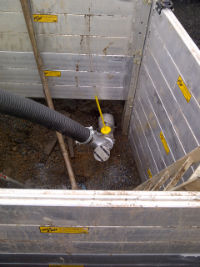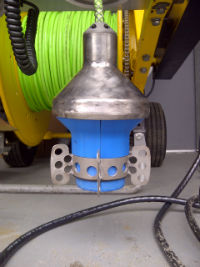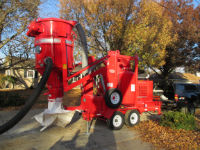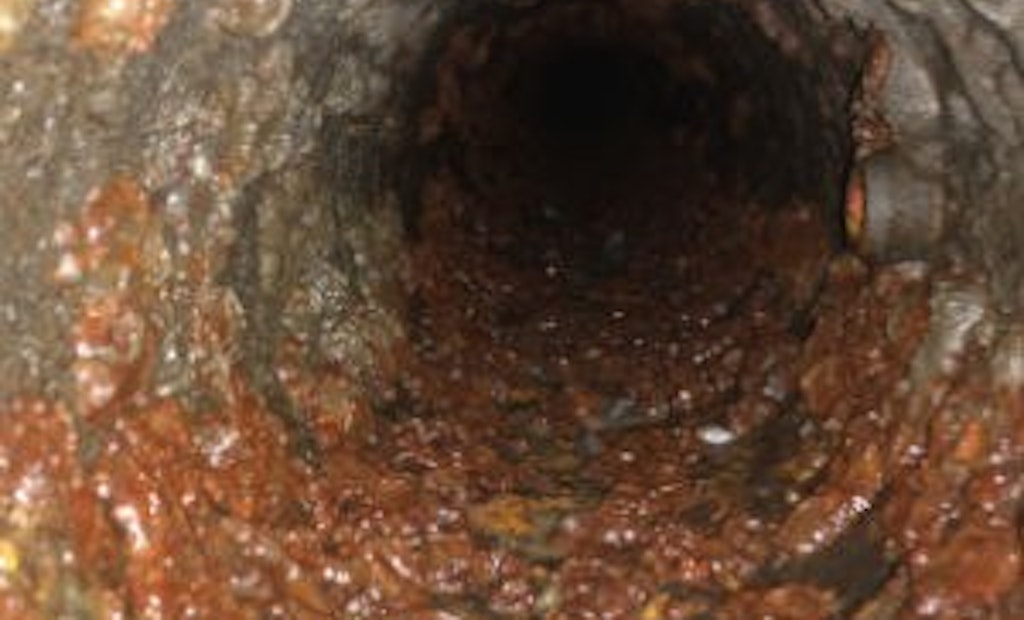Interested in Cleaning?
Get Cleaning articles, news and videos right in your inbox! Sign up now.
Cleaning + Get AlertsOne of the costliest aspects of relining potable water pipes is the provision of pipeline by-pass systems to provide temporary water to customers as the line is cleaned, then dried in preparation for the new liner. Envirologics Engineering Inc. of Bracebridge, Ontario, Canada, has developed a waterless system that uses dry abrasives to scour pipes, leaving a clean and dry pipe surface ready for immediate relining.
 The Tomahawk System works by vacuum. It draws abrasives through up to 450 feet of pipe, using a high-volume, low-pressure air stream, which also dries out pipe interiors. The grit is washed, crushed, graded and heated to kill bacteria. Larger grit is used for the toughest cleaning jobs. The vacuum source is flexible, but often involves the use of a standard vacuum truck.
The Tomahawk System works by vacuum. It draws abrasives through up to 450 feet of pipe, using a high-volume, low-pressure air stream, which also dries out pipe interiors. The grit is washed, crushed, graded and heated to kill bacteria. Larger grit is used for the toughest cleaning jobs. The vacuum source is flexible, but often involves the use of a standard vacuum truck.
“By drawing the aggregate with vacuum, rather than pushing, you can deliver as much stone as you want,” says Brian Thorogood P. Eng, program manager with Envirologics. “With a vacuum truck at the receiving end, you’re capturing all of the used aggregate, not spewing it into the environment.”
Envirologics requires a small launch pit — about 4 by 6 feet — to access the pipe. Typically, a slightly larger pit — about 4 by 8 feet — is excavated to accommodate relining equipment.
Proven methods
The company has been using the system for about five years, working on contracts with several Canadian cities in Ontario, including Napanee, Peterborough and Cambridge. While Envirologics has worked with a number of pipe relining contractors, much of its work has been conducted in partnership with 3M-certified contractors.
The first U.S. application of the system occurred in 2013 on behalf of the public works department of the City of Moline, Ill. The goal of the project: to scour five sections of 6-inch cast iron pipe totaling more than 1,400 feet and reline it with same-day return-to-service. The pipe sections had experienced repeated service failures and heavy tuberculation blamed for severe water discoloration. The public works department wanted to place an immediate barrier between the newly scoured cast iron surface and the water to prevent the problem from repeating.
“We used the city’s Vactor on the receiving end to supply negative pressure, which saved the city some money,” says Thorogood. “On each section we cleaned the pipe of tuberculation, and 3M moved in with its Scotchkote Liner 2400 pipe lining system, achieving same-day return-to-service for each of the segments.”
Tweaking the system
Thorogood notes the system has evolved since it was devised five years ago, first switching from a positive air system to a vacuum and then developing additional features.
 The company’s Tomahawk Scout is a system that uses a CCTV system to inspect the pipe in real time, to ensure the pipe contains no trouble spots that may require additional remediation or drying. A stone deflector placed on the back of the unit lets the Scout inspect the pipe even when aggregate is airborne.
The company’s Tomahawk Scout is a system that uses a CCTV system to inspect the pipe in real time, to ensure the pipe contains no trouble spots that may require additional remediation or drying. A stone deflector placed on the back of the unit lets the Scout inspect the pipe even when aggregate is airborne.
A series of purpose-built quick-connect attachments has also significantly reduced the time required to integrate equipment with water lines.
Moline gave Envirologics permission to clean a section of pipe using a Hurricane 755 Industrial Vacuum unit with a HEPA filter.
 “The Hurricanes are used for asbestos remediation of buildings,” says Thorogood. “The Moline project didn’t involve any asbestos, but our success with the Hurricane validated for us that we can successfully and safely clean and remediate asbestos cement (AC) pipe using air-driven abrasives. Remediating AC pipe is a huge current problem without a solution.”
“The Hurricanes are used for asbestos remediation of buildings,” says Thorogood. “The Moline project didn’t involve any asbestos, but our success with the Hurricane validated for us that we can successfully and safely clean and remediate asbestos cement (AC) pipe using air-driven abrasives. Remediating AC pipe is a huge current problem without a solution.”
Envirologics has upcoming projects in several Canadian cities including Quebec City, and in Vancouver and Victoria, British Columbia. One of its most recent projects was a second engagement in St. John, New Brunswick, cleaning out water pipes lined with bitumen.
“You can’t line the pipe until the bitumen is gone, because you won’t get good adhesion,” says Thorogood. “However, as it breaks down you get water quality issues. This pipe had both bitumen on top and tuberculation on the bottom.”
The project involved cleaning a half-mile of cast iron pipe between 6 and 8 inches in diameter. Total time required to clean and line the pipes: six working days. Each section achieved a same-day return-to-service.
“What we like best about the photos of the St. John project is that they show almost nothing on the surface,” says Thorogood. “Just nice, normal street conditions with a vacuum truck and trailer parked on the side of the road.”







